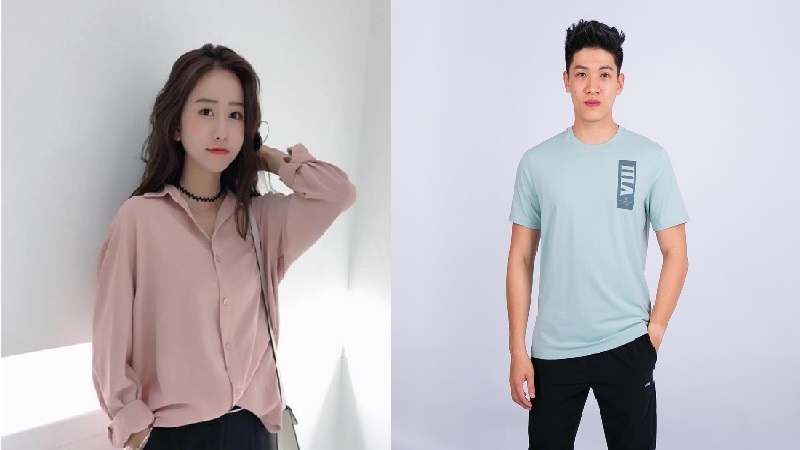Clothing serves not only to keep us warm but also to express our personal fashion sense. When shopping for a new shirt, size is an essential factor to ensure a comfortable fit. So, how do you choose a shirt that’s the right size? Let’s explore this topic further in the article below!
1 What Do S, M, L, and XL Mean?
 What Do S, M, L, and XL Mean?
What Do S, M, L, and XL Mean?
Shirt size refers to the dimensions of a shirt and is determined by an individual’s height and weight. The letters S, M, L, and XL are abbreviations for words indicating clothing sizes according to international standards:
S stands for “Small” and is for individuals with a petite frame.
M stands for “Medium” and caters to individuals with an average build and a medium weight range.
L represents “Large” and is suitable for individuals with a taller or larger frame.
XL, which stands for “Extra Large,” is designed for individuals with a taller or larger frame, often referred to as “plus-size.”
2 Why Standardize Clothing Sizes?
 Why Standardize Clothing Sizes?
Why Standardize Clothing Sizes?
Standardizing clothing sizes is essential as it helps individuals find garments that fit their unique body types. Wearing well-fitting clothes boosts confidence and makes you feel comfortable during work, study, or any other activity.
Size standardization also helps you avoid choosing clothes that are too loose or too tight. Additionally, dressing according to your body type can enhance your appearance and make you more attractive to those around you. It can even help disguise physical flaws, such as making a short person look taller or a skinny person look more robust.
3 How to Choose the Right Shirt Size
To select a shirt that flatters your figure, consider your body type, height, and weight. Accurate body measurements are crucial to choosing the correct size, as even a slight measurement error can lead to an ill-fitting garment.
 How to Choose the Right Shirt Size
How to Choose the Right Shirt Size
Choosing a Shirt Size Based on Height and Weight
Shirt Size Guide for Men
|
Height
|
Weight
|
Size
|
|
160 – 165 cm
|
55 – 60 kg
|
S
|
|
164 – 169 cm
|
60 – 65 kg
|
M
|
|
170 – 174 cm
|
66 – 70 kg
|
L
|
|
174 – 176 cm
|
70 – 76 kg
|
XL
|
|
165 – 177 cm
|
76 – 80 kg
|
XXL
|
Shirt Size Guide for Women
|
Height
|
Weight
|
Size
|
|
148 – 153 cm
|
38 – 43 kg
|
S
|
|
153 – 155 cm
|
43 – 46 kg
|
M
|
|
153 – 158 cm
|
46 – 53 kg
|
L
|
|
155 – 162 cm
|
53 – 57 kg
|
XL
|
|
155 – 166 cm
|
57 – 66 kg
|
XXL
|
Choosing a Shirt Size Based on Bust, Waist, and Hip Measurements
Shirt Size Guide for Women
| UK Size | US Size | Bust | Waist | Hip | Height (cm) |
| S | 6 | 73 – 76 cm | 62 – 65 cm | 80 – 82 cm | 146 – 148 cm |
| S | 8 | 77 – 81 cm | 65 – 66.5 cm | 83 – 84.5 cm | 148 – 151 cm |
| M | 19 | 82 – 86 cm | 66.5 – 69 cm | 85 – 87 cm | 151 – 155 cm |
| M | 12 | 87 – 91 cm | 69 – 71.5 cm | 88 – 89.5 cm | 155 – 157 cm |
| L | 14 | 92 – 96 cm | 71.5 – 74 cm | 90 – 92 cm | 157 – 160 cm |
| L | 16 | 97 – 101 cm | 74.5 – 76.5 cm | 93 – 94.5 cm | 160 – 163 cm |
| XL | 18 | 102 – 106 cm | 77 – 99 cm | 95 – 97 cm | 163 – 166 cm |
| XL | 20 | 107 – 111 cm | 99.5 – 81.5 cm | 98 – 99.5 cm | 166 – 169 cm |
Shirt Size Guide for Men
| UK Size | Neck Size | Chest Size (Bust) | Waist Size |
| S | 38 – 39 cm | 81 – 90 cm | 69 – 77 cm |
| M | 39 – 41 cm | 90 – 105 cm | 77 – 83 cm |
| L | 41 – 43 cm | 105 – 116 cm | 83 – 89 cm |
| XL | 43 – 45 cm | 116 – 128 cm | 89 – 97 cm |
Choosing a Shirt Size Based on Shirt Length, Shoulder Width, and Chest Width
Shirt Size Guide for Men
|
Size
|
Shirt Length (cm)
|
Chest Width (cm)
|
Shoulder Width (cm)
|
|
S
|
66
|
48
|
40
|
|
M
|
68.5
|
50
|
42
|
|
L
|
71
|
52
|
44
|
|
XL
|
73.5
|
54
|
46
|
|
XXL
|
76
|
56
|
48
|
|
3XL
|
78.5
|
58
|
50
|
Shirt Size Guide for Women
|
Size
|
Shirt Length (cm)
|
Chest Width (cm)
|
Shoulder Width (cm)
|
|
S
|
58
|
42
|
32
|
|
M
|
60
|
43
|
34
|
|
L
|
63
|
44
|
36
|
|
XL
|
66
|
48
|
40
|
|
XXL
|
68
|
50
|
43
|
4 Popular Shirt Size Charts
Shirt Size Chart for Men































